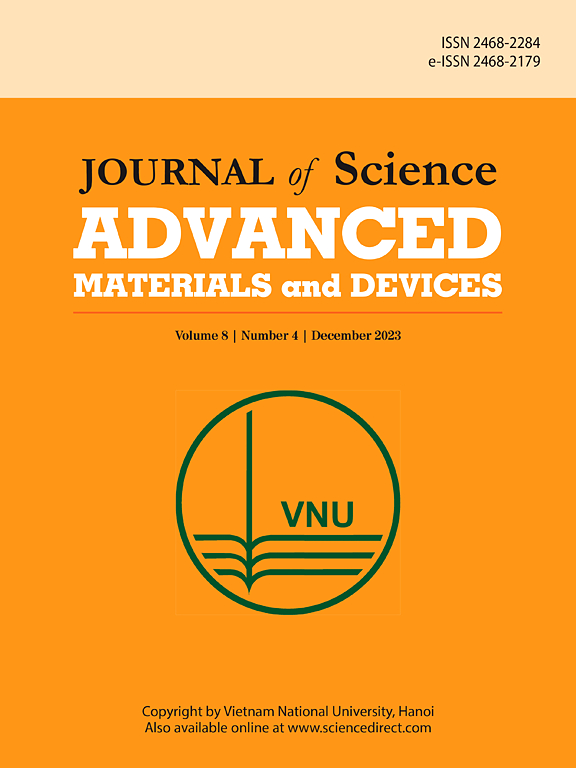Fuel-assisted sol-gel combustion synthesis of monticellite: Structural, mechanical, and biological characterization for tissue engineering
IF 6.8
3区 材料科学
Q1 MATERIALS SCIENCE, MULTIDISCIPLINARY
Journal of Science: Advanced Materials and Devices
Pub Date : 2025-07-14
DOI:10.1016/j.jsamd.2025.100951
引用次数: 0
Abstract
Silicate ceramics hold significant potential in tissue engineering, particularly as effective bone graft substitutes for the repair of bone defects. The current study explores the pivotal role of fuel selection in tailoring the properties of monticellite synthesized via sol-gel combustion technique using citric acid, glycine, and urea as fuels. X-ray diffraction patterns confirmed the formation of single-phasic monticellite at 1200 °C with glycine and urea as fuels, underscoring the essential role of fuel in phase formation. Monticellite synthesized with citric acid as fuel (MC) exhibited a higher surface area, which facilitated superior apatite formation, indicating enhanced bioactivity. In contrast, the increased particle size and effective grain growth of monticellite obtained through glycine (MG) contributed to mechanical strength values comparable to those of human cortical bone. Monticellite demonstrated strong antibacterial activity against clinical pathogens, coupled with notable anti-inflammatory properties and excellent hemocompatibility. MC, MG, and monticellite derived using urea (MU) scaffolds supported human-adipose-derived mesenchymal stem cell attachment and significant viability and osteogenic gene expression (BMP2, COLI, and OPN) when compared with monolayer culture. This comprehensive investigation underscores the substantial impact of fuel selection on monticellite's properties, offering a strategic approach for optimizing its characteristics with enhanced functionality for hard tissue regeneration.

燃料辅助溶胶-凝胶燃烧合成monticellite:组织工程的结构、力学和生物学表征
硅酸盐陶瓷在组织工程中具有巨大的潜力,特别是作为骨缺损修复的有效骨移植替代物。目前的研究探索了燃料选择在利用柠檬酸、甘氨酸和尿素作为燃料,通过溶胶-凝胶燃烧技术合成monticellite的特性中所起的关键作用。x射线衍射图证实了以甘氨酸和尿素为燃料在1200℃下形成的单相monticellite,强调了燃料在相形成中的重要作用。以柠檬酸为燃料合成的蒙脱石具有更高的表面积,有利于磷灰石的形成,表明生物活性增强。相比之下,通过甘氨酸(MG)获得的monticellite的粒径增加和有效晶粒生长有助于获得与人类皮质骨相当的机械强度值。Monticellite对临床病原菌具有较强的抗菌活性,具有显著的抗炎特性和良好的血液相容性。与单层培养相比,使用尿素(MU)支架获得的MC、MG和monticellite支持人脂肪来源的间充质干细胞附着,并具有显著的活力和成骨基因表达(BMP2、COLI和OPN)。这项全面的研究强调了燃料选择对monticellite性能的重大影响,为优化其特性和增强硬组织再生功能提供了一种战略方法。
本文章由计算机程序翻译,如有差异,请以英文原文为准。
求助全文
约1分钟内获得全文
求助全文
来源期刊

Journal of Science: Advanced Materials and Devices
Materials Science-Electronic, Optical and Magnetic Materials
CiteScore
11.90
自引率
2.50%
发文量
88
审稿时长
47 days
期刊介绍:
In 1985, the Journal of Science was founded as a platform for publishing national and international research papers across various disciplines, including natural sciences, technology, social sciences, and humanities. Over the years, the journal has experienced remarkable growth in terms of quality, size, and scope. Today, it encompasses a diverse range of publications dedicated to academic research.
Considering the rapid expansion of materials science, we are pleased to introduce the Journal of Science: Advanced Materials and Devices. This new addition to our journal series offers researchers an exciting opportunity to publish their work on all aspects of materials science and technology within the esteemed Journal of Science.
With this development, we aim to revolutionize the way research in materials science is expressed and organized, further strengthening our commitment to promoting outstanding research across various scientific and technological fields.
 求助内容:
求助内容: 应助结果提醒方式:
应助结果提醒方式:


